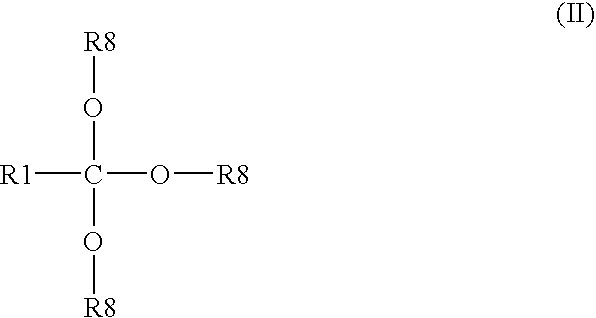Environmentally-friendly oil/water demulsifiers
a technology of oil/water demulsifier and environmental protection, which is applied in the direction of hair cosmetics, other chemical processes, separation processes, etc., can solve the problems of poor biodegradability, severe hiccups in separation, and significant mixing energy
- Summary
- Abstract
- Description
- Claims
- Application Information
AI Technical Summary
Benefits of technology
Problems solved by technology
Method used
Image
Examples
example 2
Step 1
[0063]One mole of triethyl orthoformate (TEOF), 0.85 moles of polypropylene glycol having an average molecular weight of 400 (PPG 400), and 0.08% w / w (on total weight of charged mixture) of anhydrous citric acid were mixed together at ambient temperature. The reaction was then carried out in a similar manner to Step 1 of Example 1.
[0064]1H-NMR analysis of the final product indicated that 47% of the orthoester links were connected to three PPG-moieties, 40% to two, and 13% to one moiety. No unreacted TEOF was found according to 1H-NMR.
Step 2
[0065]In the subsequent step, the PPG-orthoester polymer was reacted with ethylene oxide in such an amount that around 64% w / w of the final product was made up of ethyleneoxy groups. The same procedure as in Step 2 of Example 1 was followed for the ethoxylation.
[0066]The RSN value was found to be 22.7.
example 3
[0067]One mole of triethyl orthoformate (TEOF), 0.75 moles of PPG 400, 0.60 moles of poly(ethylene glycol) monomethyl ether having an average molecular weight of 350 (MPEG 350), and 0.08% w / w (on total weight of charged mixture) of anhydrous citric acid were mixed together at ambient temperature. The mixture was heated rapidly to 125° C. and then stepwise up to 160° C. The reaction was carried out in a similar manner to Step 1 of Example 1.
[0068]The formation of the PPG-MPEG block polymer with built-in orthoester links was followed by 1H-NMR, which enabled quenching of the reaction at the desired degree of polymerization. No unreacted TEOF was found in the end product according to 1H-NMR. SEC chromatography indicated a broad molecular weight distribution with an average Mw of 4,000.
[0069]The RSN value was found to be 17.1.
Example 4
[0070]One mole of triethyl orthoformate (TEOF), 0.71 moles of PPG 400, 0.11 moles of butyl diglycol (BDG, diethylene glycol monobutyl ether), and 0.11% w / ...
example 5
[0073]One mole of triethyl orthoformate (TEOF), 0.90 moles of PPG 400, 0.35 moles of a C9 / 11 fatty alcohol reacted with 8 moles of ethylene oxide (Berol® OX 91-8), and 0.08% w / w (on total weight of charged mixture) of anhydrous citric acid were mixed together at ambient temperature. The reaction was then carried out in a similar manner to Step 1 of Example 1.
[0074]The formation of the PPG-fatty alcohol ethoxylate block polymer with built-in orthoester links was followed by 1H-NMR. No unreacted TEOF was found in the end product according to 1H-NMR. SEC chromatography showed a broad molecular weight distribution with an average Mw of 7,600.
[0075]The RSN value was found to be 9.6.
PUM
| Property | Measurement | Unit |
|---|---|---|
| polydispersity | aaaaa | aaaaa |
| temperatures | aaaaa | aaaaa |
| temperature | aaaaa | aaaaa |
Abstract
Description
Claims
Application Information
 Login to View More
Login to View More - R&D
- Intellectual Property
- Life Sciences
- Materials
- Tech Scout
- Unparalleled Data Quality
- Higher Quality Content
- 60% Fewer Hallucinations
Browse by: Latest US Patents, China's latest patents, Technical Efficacy Thesaurus, Application Domain, Technology Topic, Popular Technical Reports.
© 2025 PatSnap. All rights reserved.Legal|Privacy policy|Modern Slavery Act Transparency Statement|Sitemap|About US| Contact US: help@patsnap.com



